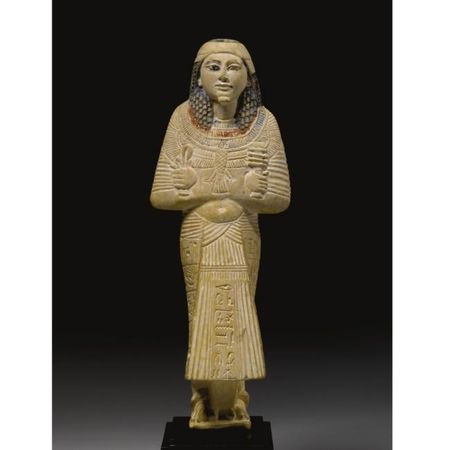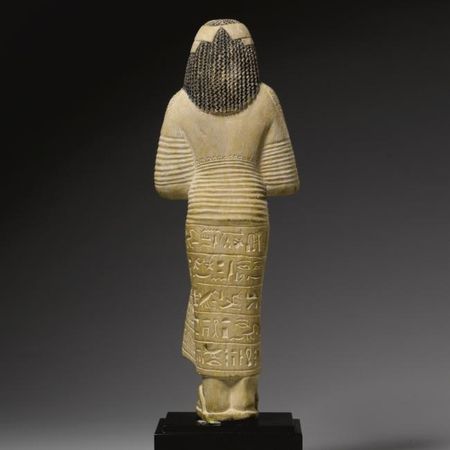An Egyptian Polychrome Limestone Ushabti of Djehuty-mose (Tothmes), Overseer of the Cattle in the Temple of Amun, 19th Dynasty
An Egyptian Polychrome Limestone Ushabti of Djehuty-mose (Tothmes), Overseer of the Cattle in the Temple of Amun, 19th Dynasty, 1292-1190 B.C. photo Sotheby's
holding a djed-pillar and Knot of Isis, and wearing a pleated shirt and kilt with overfold, a ba-bird with wings outstretched on the chest, broad beaded collar, short beard, and double wig of echeloned and zig-zag curls bound in a headband, his face with full outlined lips indented at the corners, straight nose, and large eyes with long eyebrows and cosmetic lines painted in black, columns and lines of inscription on the kilt.; height 12 3/8 in. 31.5 cm. Estimate 200,000—300,000 USD. Lot Sold 1,314,500 USD
PROVENANCE: Omar Pacha Sultan, Cairo, 1920s
Mathias Komor, New York [E.724], June 30th, 1975
LITERATURE AND REFERENCES; Collection de feu Omar Pacha Sultan, Le Caire. Catalogue descriptif. Vol. 1: Art égyptien, Paris, 1929, no. 303, pls. XLII (Vitrine 2 bis) and XLV
Jacques-F. and Liliane Aubert, Statuettes égyptiennes. Chaouabtis, ouchebtis, Paris, 1974, p. 89
Jacques-F. Aubert, "Les statuettes funéraires de la Collection Omar Pacha," Chroniques d'Égypte, vol. LI, 1976, no. 303
NOTE: The present ushabti is one of a very small group of private ushabtis (all for different owners) inscribed with the hallowed Khamuas formula: others are in Leiden (3.2.1.31 and 3.2.1.19), Cairo (47220 and JE 11092), London (33921), and Vienna; another was sold at Sotheby's, London, December 3rd, 1973, no. 37 (see Aubert, op. cit., 1974, cover illus). The Khamuas formula takes its name from the ushabtis of prince Khamuas or Khaemwaset, a son of Ramesses II on whose ushabtis this magical spell appears for the first time. As an antiquarian and magician Khaemwaset is thought to have devised the formula himself in order to facilitate the entry of the deceased into Roset-au (the domain of Osiris), the freedom to move within its boundaries, and the securing of land and workers therein. The spell, which the owner speaks to the ushabti, usually runs as follows: "May your face be opened so that you see the sun-disk and that you adore the Sun in life. May you be summoned in Roset-au, and circle the mound of Tja-mut, traverse the valley of Upper Roset-au and open the Secret Cavern. May you take place upon your seat which is in Ta-djeser, like the great crew members who are in Re." (H.H. Schneider, Shabtis, Part I, Leiden, 1977, p. 285); the author notes that the formula is "especially composed to raise the owner of the shabti to a higher, divine level, and to make him a citizen, as it were, of the sacred region of Roset-au."
Sotheby's. Antiquities from the Collection of the Late Clarence Day. 07 Dec 10. New York www.sothebys.com

/https%3A%2F%2Fprofilepics.canalblog.com%2Fprofilepics%2F1%2F0%2F100183.jpg)






/http%3A%2F%2Fstorage.canalblog.com%2F41%2F40%2F119589%2F61814301_p.jpg)
/http%3A%2F%2Fstorage.canalblog.com%2F39%2F17%2F119589%2F59530325_p.jpg)
/http%3A%2F%2Fstorage.canalblog.com%2F24%2F22%2F119589%2F57607212_p.jpg)
/http%3A%2F%2Fstorage.canalblog.com%2F21%2F10%2F119589%2F53089735_p.jpg)